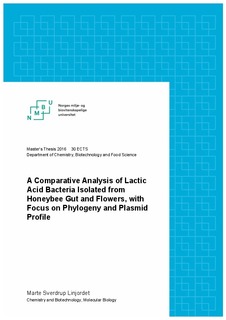| dc.contributor.advisor | Diep, Dzung Bao | |
| dc.contributor.advisor | Münch, Daniel | |
| dc.contributor.author | Linjordet, Marte S. | |
| dc.coverage.spatial | Norway, Ås. | nb_NO |
| dc.date.accessioned | 2016-08-10T11:53:20Z | |
| dc.date.available | 2016-08-10T11:53:20Z | |
| dc.date.issued | 2016-08-10 | |
| dc.identifier.uri | http://hdl.handle.net/11250/2398654 | |
| dc.description.abstract | Apis mellifera (honeybee) are of huge value as they are the most important pollinator worldwide. Declines in honeybee populations have made the honeybee subject to much scientific research. Lactic acid bacteria (LAB) have been discovered in the honeybee gut and are believed to be of great importance to the honeybee health, protecting them against bee pathogens. Comparing LAB communities in the honeybee gut to those found on flowers may help highlight the route and importance of floral transmission.
Using cultivation techniques selective for Lactobacillus, plasmid and fermentation profiling, and 16S rDNA sequencing, LAB were isolated from dandelion, apple, rapeseed, raspberry and willowherb and compared to the LAB isolated from honeybee guts.
The results showed that Lactobacillus kunkeei and Fructobacillus fructosus were the most abundant of all the identified species in both honeybee gut and flowers samples. The LAB flora of the honeybee gut seems to shift from L. kunkeei to F. fructosus through May to late June, and F. fructosus was also found as the most abundant LAB in one of the samples collected from honeybee guts in August. This is in accordance with the LAB flora found on dandelion and apple in May and raspberry in late June, giving indications toward a positive correlation between the LAB microbial flora in honeybee gut and the flowers within their foraging area. The results also showed that the plasmid profiles were more diverse in the honeybee gut samples, and although there seemed to be four profiles that also occurred in the flower samples, indicating possible relatedness on strain level, the data sets are relatively small and further investigations are needed. | nb_NO |
| dc.description.abstract | Apis mellifera (honningbie) er av stor verdi og er den viktigste pollinatoren over hele
verden. Reduksjoner av honningbiens populasjon har gjort at honningbien er underlagt
mye vitenskapelig forskning. Melkesyrebakterier har blitt oppdaget i tarmen til
honningbien og antas å være av stor betydning for honningbiens helse, hvor de
beskytter dem mot bie-patogener. Sammenligning av melkesyrebakteriene i
honningbiens tarm og de som finnes på blomster kan kanskje hjelpe til med å markere
veien og viktigheten av bakteriell blomsteroverføring. Ved hjelp av dyrketeknikker som
er selektive for Lactobacillus, plasmid- og fermenteringsprofilering, og 16S rDNA
sekvensering, ble melkesyrebakteriene isolert fra løvetann, eple, raps, bringebær og
geitrams og sammenlignet med melkesyrebakteriene isolert fra tarmen til honningbien.
Resultatene viste at Lactobacillus kunkeei og Fructobacillus fructosus var de mest tallrike
av alle de identifiserte artene i både honningbietarmen og blomsterprøvene.
Melkesyrebakteriefloraen i tarmen ser ut til å skifte fra L. kunkeei til F. fructosus
gjennom mai til slutten av juni, og F. fructosus ble også funnet som den mest tallrike
melkesyrebakterien i en av prøvene samlet inn fra bie-tarmer i august. Dette er i
samsvar med floraen som ble funnet på løvetann og eple i mai og på bringebær i slutten
av juni, noe som gir indikasjoner mot en positiv korrelasjon mellom
melkesyrebakteriefloraen i tarmen og blomstene i bienes pollineringsområde.
Resultatet viste også at plasmidprofilene var mer variert i honningbieprøvene, og selv
om det så ut til å være fire profiler som også opptrådde i blomster prøvene, noe som kan
indikere slektskap på stammenivå, var datasettene relativt små og videre undersøkelser
er derfor nødvendig. | nb_NO |
| dc.language.iso | eng | nb_NO |
| dc.publisher | Norwegian University of Life Sciences, Ås | |
| dc.title | A comparative analysis of lactic acid bacteria isolated from honeybee gut and flowers, with focus on phylogeny and plasmid profiling | nb_NO |
| dc.type | Master thesis | nb_NO |
| dc.source.pagenumber | 30 | nb_NO |
| dc.description.localcode | M-KB | nb_NO |
